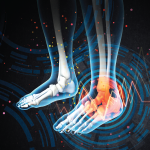Overall, the hazard ratio (HR) for lymphoma was increased in RA to 1.6 (95% confidence interval [95% CI] 1.2–2.1). Taking duration of disease into account, risk did not appear to decline over successive calendar years past initial diagnosis.
TNFi No Risk Impact Oral Corticosteroids Cut Risk in First Year
When medication usage was assessed, neither the use of methotrexate during the first year of diagnosis nor the use of TNFis ever increased lymphoma risk (HR 0.9 [95% CI 0.4–1.9]). Use of oral corticosteroids in the first year was associated with a reduced risk of lymphoma (HR 0.5 [95% CI 0.3–0.9]).
“There has been a longstanding concern that TNFi agents may induce lymphoma development,” says Dr. Hellgren. “In the present study, we found that there was no increased risk of lymphoma associated with TNFi therapy during the study period. There was also a lack of association between lymphoma risk and methotrexate treatment during the first year following RA diagnosis.”
Inflammatory Activity Not Predictive
Inflammatory activity during the first year after diagnosis was not predictive of future lymphoma risk. They found no association between risk and the 28-joint Disease Activity Score (DAS28) levels at diagnosis or one year of follow-up. Using DAS28 to estimate risk with respect to accumulated inflammatory activity during the first year was not significantly associated with either high or low aggregated values.
When the researchers looked at specific subtypes of lymphomas, chronic lymphocytic leukemia was seen less often than in the general population. On the other hand, Hodgkin’s lymphoma occurred more frequently.
“We concluded that the risk of lymphoma remains increased in a similar magnitude as was reported in historical cohorts,” says Dr. Hellgren. “Reassuringly, our standard early RA therapy during the first year following RA diagnosis and TNFi exposure any time during the study period does not seem to be associated with increased lymphoma risk in incident RA patients. On the contrary, we observed a reduced risk associated with oral corticosteroid use during the first year.”
She points out that the finding of inflammatory activity at diagnosis and in the first year following RA diagnosis was not a predictor of developing a future lymphoma. It is important to stress that this does not rule out that an accumulation of continuous inflammatory activity over many years could be important.
“From a lymphoma perspective, the finding of reduced risk in association with oral corticosteroids is of particular interest to clinicians given their anti-inflammatory effect profile,” says Dr. Hellgren.


